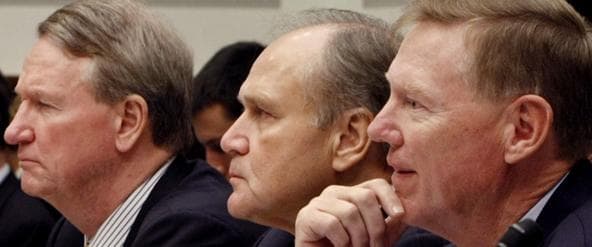Advertisement
Advice To The Next President: Economic Recovery
Introduction
What will it take to put Americans back to work?
And what industry policies do we need when entire economic sectors get in trouble?
Thomas Kochan of MIT’s Sloan School of Management and John Kwoka of Northeastern University weigh in.
 Thomas Kochan is the George Maverick Bunker Professor of Management and co-director of the Institute for Work & Employment Research at MIT's Sloan School of Management.
Thomas Kochan is the George Maverick Bunker Professor of Management and co-director of the Institute for Work & Employment Research at MIT's Sloan School of Management.To make up for jobs lost in the Great Recession and for labor force growth to occur, the U.S. needs to create 20 million new jobs by 2020. This can happen if the next president initiates a national jobs compact to speed job creation, increase wage growth, and begin modernizing federal policies and work regulations. A successful jobs compact will require a new level of coordination and collaboration among business, labor, education, and government.
The seeds of a successful national jobs strategy already exist in the many successful regional education and training partnerships that link employers, educators and students through apprenticeships, community colleges, university co-ops and other programs. These models vary in details, but they all foster the development of high-level job skills which result in increased wages and incomes.
A successful jobs compact will require a new level of coordination and collaboration among business, labor, education, and government.
Rising production costs in China and improved productivity in American manufacturing firms could make U.S. manufacturers more competitive globally in the coming years, creating up to three million high-skill, high-wage U.S. jobs. Rebuilding apprenticeships, investing in community colleges and training recent college grads in needed science, technology, engineering and mathematics (STEM) skills could produce another 5.5 million jobs.
Labor unions are now willing to invest $10 billion from pension funds to spur needed infrastructure investment. If matched by Wall Street and the federal government, this investment pool could create another 4 million jobs. Normal economic growth would close the remaining jobs deficit.
While there is no single silver bullet to solve the immediate jobs crisis, the actions outlined here address the root causes of these problems and could accelerate the creation of high-quality jobs needed to close our current jobs deficit.

 John Kwoka is the Neal F. Finnegan Professor of Economics at Northeastern University.
John Kwoka is the Neal F. Finnegan Professor of Economics at Northeastern University.The Great Recession provided vivid and painful examples about the importance of good industrial policy for the nation's economic well-being. Here are, in my view, some of the key lessons learned that the next president should put to use.
The federal government should "bail out" a company or industry only as a last resort, and only if the company's failure would have a broader impact on the nation's economy.
The Great Recession provided vivid and painful examples about the importance of good industrial policy for the nation's economic well-being.
If the federal government does decide to "bail out" a company, it should take full control of and transform the company by changing its operations and incentives. It should hold individuals personally responsible for their actions (e.g. fire CEO, managers, directors, no "golden parachutes,", institute legal proceedings if actions seemed criminal). And it should then get out as quickly as possible, returning the company to private control.
The 2008-09 auto bailout begun by President Bush and continued by President Obama is an example of how to do it right. Previous management was fired, labor contracts were rewritten, and radical changes in operations were imposed. GM, Ford, and Chrysler are all now profitable, increasing sales, reopening plants and hiring new workers.
By contrast, the Wall Street bailout — with no restructuring of large banks, no replacement of CEOs or Boards, and scant efforts to prosecute companies or individuals — is an example of how not to do it. The banks got relief without responsibility; taxpayers footed the bill and got nothing in return but increased bank profits. Even worse, the banks now have reason to believe the government will bail them out next time they get in trouble.
Related content:
This program aired on October 2, 2012. The audio for this program is not available.